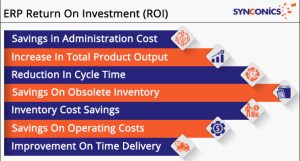Introduction
Investing in an Enterprise Resource Planning (ERP) system is a significant decision that can greatly impact an organization’s operations, efficiency, and profitability. However, understanding and measuring the Return on Investment (ROI) for an ERP system is crucial to determine whether the investment delivers the anticipated benefits. This article explores the key factors in measuring ERP ROI, including the calculation methods, key performance indicators (KPIs), and strategies for evaluating the success of your ERP investment.

1. Understanding ERP ROI
A. Definition of ROI
Return on Investment (ROI) measures the profitability of an investment relative to its cost. For an ERP system, ROI assesses the financial benefits gained from the system compared to the initial and ongoing costs associated with the implementation and maintenance of the ERP solution.
B. Components of ERP ROI
ROI for an ERP system encompasses various components, including:
- Cost Savings: Reduction in operational costs due to improved efficiency and automation.
- Increased Revenue: Enhanced business capabilities leading to higher sales or new revenue streams.
- Productivity Gains: Improved employee productivity and time savings.
- Operational Improvements: Enhanced accuracy, reduced errors, and streamlined processes.
2. Calculating ERP ROI
A. Identify Costs
1. Initial Costs
Initial costs include software licensing, hardware, implementation services, customization, and training. Summarize these costs to determine the total upfront investment.
2. Ongoing Costs
Ongoing costs involve annual maintenance fees, subscription fees (for cloud-based solutions), support services, and any additional costs for system upgrades or enhancements. Include these costs in your ROI calculation.
B. Determine Benefits
1. Cost Savings
Quantify cost savings resulting from process automation, reduced manual effort, and minimized errors. Examples include reduced administrative costs, lower inventory carrying costs, and decreased operational expenses.
2. Revenue Increases
Assess any increases in revenue attributable to the ERP system. This might include improved customer service leading to higher sales, better inventory management reducing stockouts and lost sales, or enhanced reporting capabilities supporting better decision-making.
3. Productivity Gains
Measure improvements in employee productivity and time savings. Calculate the value of time saved through automation and streamlined processes, and consider how this time savings translates into increased output or reduced labor costs.
4. Operational Improvements
Evaluate the impact of operational improvements such as reduced order processing times, faster financial close cycles, and improved accuracy in reporting and compliance. Quantify the benefits in terms of time, cost, and overall efficiency.
C. Calculate ROI
1. ROI Formula
Use the following formula to calculate ROI:
ROI=Net BenefitsTotal Costs×100\text{ROI} = \frac{\text{Net Benefits}}{\text{Total Costs}} \times 100ROI=Total CostsNet Benefits×100
where Net Benefits = Total Benefits – Total Costs.
2. Example Calculation
Suppose your ERP system has total costs of $500,000 (including initial and ongoing costs) and generates annual benefits of $800,000 (including cost savings, revenue increases, and productivity gains). The ROI calculation would be:
ROI=(800,000−500,000)500,000×100=60%\text{ROI} = \frac{(800,000 – 500,000)}{500,000} \times 100 = 60\%ROI=500,000(800,000−500,000)×100=60%
3. Analyzing ROI Results
A. Positive ROI
A positive ROI indicates that the ERP system is generating more benefits than the costs incurred. Analyze the specific areas contributing to the ROI to understand where the system is delivering the most value.
B. Negative or Low ROI
A negative or low ROI may suggest that the ERP system is not meeting expectations. Investigate potential issues, such as underutilization, inadequate training, or technical problems, and consider corrective actions to improve the ROI.
4. Key Performance Indicators (KPIs) for ERP ROI
A. Cost Reduction Metrics
1. Operational Cost Savings
Measure reductions in operational costs such as administrative expenses, inventory carrying costs, and labor costs.
2. Error Reduction
Track reductions in errors related to manual processes, such as data entry errors or order processing mistakes.
B. Revenue Metrics
1. Sales Growth
Analyze changes in sales revenue attributed to improved business processes or enhanced customer service.
2. Customer Retention and Acquisition
Evaluate improvements in customer retention rates and the acquisition of new customers as a result of better service and system capabilities.
C. Productivity Metrics
1. Time Savings
Measure time saved through automation and process improvements, and quantify the impact on overall productivity.
2. Employee Efficiency
Assess improvements in employee efficiency and output as a result of streamlined workflows and reduced manual tasks.
D. Operational Efficiency Metrics
1. Process Cycle Times
Track reductions in process cycle times, such as order fulfillment or financial closing cycles.
2. Reporting Accuracy and Timeliness
Evaluate improvements in the accuracy and timeliness of financial and operational reporting.
5. Strategies for Maximizing ERP ROI
A. Invest in Training and Change Management
1. Comprehensive Training
Ensure that employees receive thorough training to maximize the use of ERP system features and functionalities. Well-trained users are more likely to leverage the system effectively and achieve desired outcomes.
2. Change Management
Implement change management strategies to facilitate a smooth transition to the ERP system. Address resistance to change and ensure that employees are prepared to adapt to new processes and workflows.
B. Optimize System Usage
1. Regularly Review and Adjust
Continuously review ERP system performance and usage. Make adjustments as needed to ensure that the system aligns with evolving business needs and maximizes its benefits.
2. Utilize Advanced Features
Explore and utilize advanced features and functionalities of the ERP system to further enhance efficiency and achieve additional benefits.
C. Monitor and Evaluate
1. Set Clear Goals and Metrics
Establish clear goals and KPIs for evaluating ERP system performance and ROI. Regularly monitor progress and assess whether the system is meeting its objectives.
2. Conduct Periodic ROI Assessments
Perform periodic ROI assessments to track the long-term impact of the ERP system and make informed decisions about future investments or improvements.
Conclusion
Measuring the ROI of an ERP system investment is essential for determining its effectiveness and value. By understanding the components of ROI, calculating benefits and costs, and analyzing performance metrics, organizations can assess whether their ERP system delivers the expected returns. Implementing strategies to maximize ERP ROI, such as investing in training, optimizing system usage, and monitoring performance, ensures that the ERP system continues to provide value and contribute to the organization’s success.
